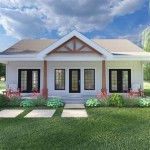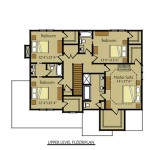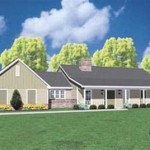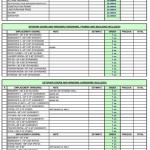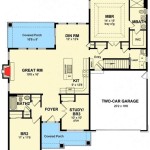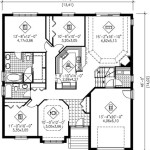Modern House and Floor Plans: Design for Contemporary Living
Modern house and floor plans represent a significant departure from traditional architectural styles, prioritizing functionality, open spaces, and seamless integration with the surrounding environment. These plans are characterized by clean lines, minimalist aesthetics, and a focus on natural light, appealing to homeowners seeking a contemporary and efficient living experience. The evolution of modern housing has been influenced by technological advancements, changing lifestyles, and a growing emphasis on sustainability.
The core principles underpinning modern house and floor plans revolve around creating flexible and adaptable living spaces. This is achieved through the strategic use of open-concept layouts, minimal interior walls, and the incorporation of multi-functional areas. The emphasis is on maximizing usable space and fostering a sense of connection between different areas of the home. This design philosophy caters to the needs of modern families and individuals who value both privacy and shared living experiences.
Furthermore, modern house plans often incorporate sustainable design elements, such as energy-efficient windows, solar panels, and rainwater harvesting systems. These features are not only environmentally conscious but also contribute to long-term cost savings for homeowners. The integration of smart home technology is also a common feature, allowing for automated control of lighting, temperature, and security systems, enhancing convenience and energy efficiency.
Key Features of Modern Floor Plans
Modern floor plans are distinguished by several key characteristics that set them apart from traditional designs. Understanding these features is crucial for homeowners considering building or renovating a modern home. These features contribute to the overall aesthetic, functionality, and livability of the space.
Open-Concept Living: The cornerstone of modern floor plans is the open-concept layout. This design eliminates or minimizes the use of walls to separate living areas such as the kitchen, dining room, and living room. This creates a spacious and airy feel, encouraging social interaction and allowing for a more fluid movement throughout the home. Open-concept layouts are particularly well-suited for entertaining and can be easily adapted to accommodate different activities. The absence of walls also allows for better natural light distribution, reducing the need for artificial lighting and creating a brighter and more inviting atmosphere.
Minimalism and Clean Lines: Modern design embraces minimalism, characterized by clean lines, geometric shapes, and a lack of ornamentation. This aesthetic extends to the floor plan itself, with a focus on simplicity and functionality. Rooms are typically rectangular or square, with minimal curves or decorative elements. This creates a sense of order and tranquility, allowing the occupants to focus on the essential elements of the space. The minimalist approach also simplifies maintenance and reduces clutter, contributing to a more relaxed and stress-free living environment.
Integration of Indoor and Outdoor Spaces: Modern house plans often blur the lines between indoor and outdoor living through the use of large windows, sliding glass doors, and outdoor living areas such as patios, decks, and balconies. This creates a seamless connection between the interior and exterior, allowing for natural light and ventilation to flow freely throughout the home. Outdoor living spaces are often designed as extensions of the interior, providing additional areas for relaxation, dining, and entertaining. This integration of indoor and outdoor spaces enhances the overall living experience and promotes a connection with nature.
Types of Modern House Plans
The term "modern house plan" encompasses a wide variety of styles and designs, each with its unique characteristics and appeal. These plans can be categorized based on their architectural style, size, and the specific needs of the homeowner. Understanding the different types of modern house plans can help homeowners make informed decisions when choosing the right design for their lifestyle and preferences.
Ranch-Style Modern Homes: Ranch-style homes are characterized by their single-story layout, low-pitched roof, and horizontal orientation. Modern ranch homes often incorporate open-concept living areas, large windows, and sliding glass doors to maximize natural light and connect the interior with the exterior. These homes are particularly well-suited for families with young children or individuals with mobility issues, as they eliminate the need for stairs. Modern ranch homes often feature updated materials and finishes, such as metal roofing, wood siding, and concrete flooring, giving them a contemporary look and feel.
Contemporary Two-Story Homes: Contemporary two-story homes offer more living space than ranch-style homes, making them ideal for larger families or those who need additional room for guests or home offices. These homes typically feature a master suite on the main floor, along with open living areas and a kitchen. The upper floor often includes bedrooms, bathrooms, and a secondary living area or playroom. Contemporary two-story homes can be designed with a variety of architectural styles, from minimalist to more traditional, depending on the homeowner's preferences. The design often emphasizes clean lines, large windows, and a balanced facade.
Modern Farmhouse Homes: Modern farmhouse homes combine the rustic charm of traditional farmhouses with the clean lines and minimalist aesthetic of modern design. These homes often feature a gabled roof, board-and-batten siding, and a large front porch. The interior typically includes open-concept living areas, a farmhouse-style kitchen, and shiplap walls. Modern farmhouse homes often incorporate natural materials such as wood, stone, and metal, creating a warm and inviting atmosphere. These homes are particularly popular in rural and suburban areas, offering a blend of comfort and style.
Considerations When Choosing a Modern Floor Plan
Selecting the right modern floor plan requires careful consideration of various factors, including the homeowner's lifestyle, budget, and site conditions. It is essential to work with an experienced architect or designer to ensure that the chosen plan meets the specific needs and preferences of the homeowner. Ignoring these considerations can lead to dissatisfaction and costly modifications later on.
Lifestyle and Needs: The floor plan should be tailored to the specific lifestyle and needs of the homeowner. Consider the number of occupants, their ages, and their individual activities. For example, a family with young children may need a dedicated playroom or a large backyard, while a couple who frequently entertain guests may require a spacious living area and a well-equipped kitchen. It is also important to consider future needs, such as the possibility of adding more family members or working from home.
Budget: The cost of building a modern home can vary significantly depending on the size, materials, and complexity of the design. It is essential to establish a realistic budget and work with the architect or designer to create a plan that fits within those financial constraints. Consider the cost of materials, labor, permits, and other associated expenses. It is also wise to factor in a contingency fund to cover unexpected costs or changes during the construction process.
Site Conditions: The topography, soil conditions, and climate of the building site can significantly impact the design and construction of the home. The floor plan should be adapted to the site conditions to maximize energy efficiency, minimize environmental impact, and ensure structural stability. For example, a home built on a sloped site may require a different foundation design than a home built on a flat site. It is also important to consider the orientation of the home to maximize natural light and ventilation, as well as to minimize heat gain in the summer and heat loss in the winter.
Modern house and floor plans represent a contemporary approach to residential design, prioritizing functionality, aesthetics, and sustainability. By understanding the key features, types, and considerations associated with modern floor plans, homeowners can make informed decisions and create a living space that perfectly suits their lifestyle and preferences. The trend towards modern design continues to evolve, driven by technological advancements and a growing awareness of environmental concerns. As a result, modern house plans are likely to remain a popular choice for homeowners seeking a stylish, efficient, and comfortable living environment.

Latest Modern House Plans Homeplan Cloud C1a

Splendid Three Bedroom Modern House Design

Modern House Plans Truoba Architects

5 Bedroom Luxury Modern Style House Plan 8591

Modern Open Floor House Plans Blog Eplans Com

Modern House Floor Plans 12 Features To Include

Two Story 4 Bedroom Sunoria Contemporary Style Home Floor Plan

2 Story Modern House Plans Houseplans Blog Com

Plan 75977 Modern Style House Floor With Covered Lanai

Unveiling Inspiring Modern Home Floor Plans

